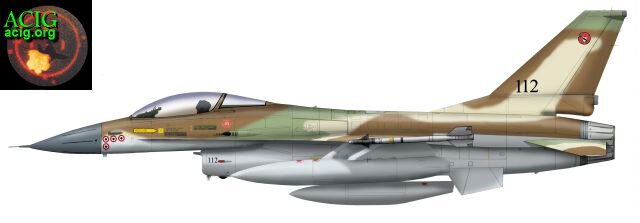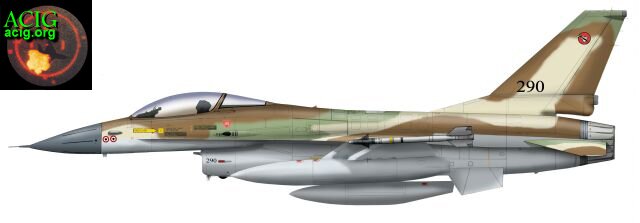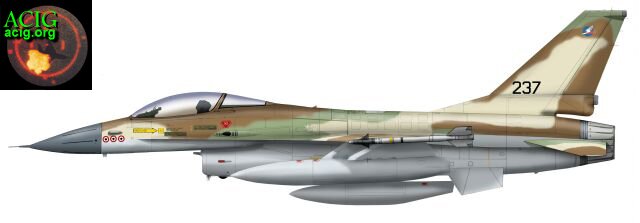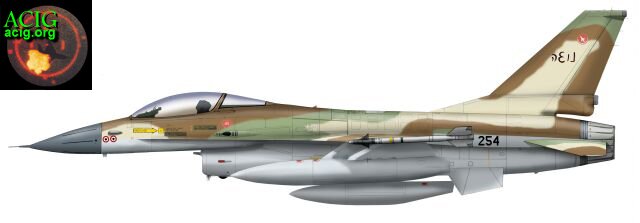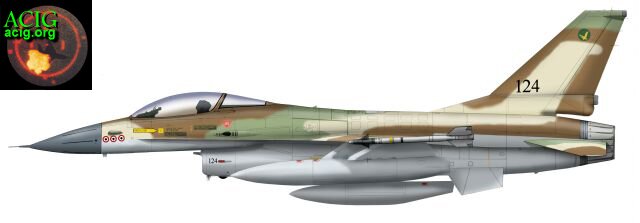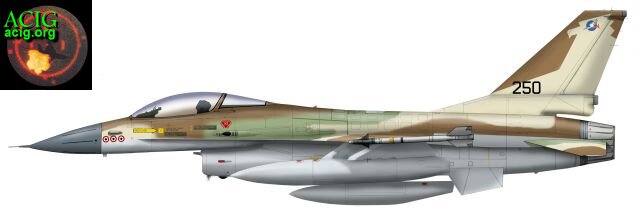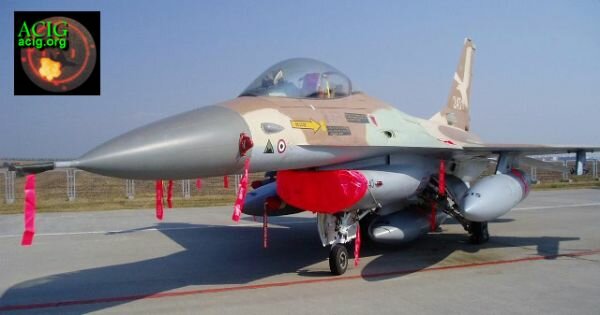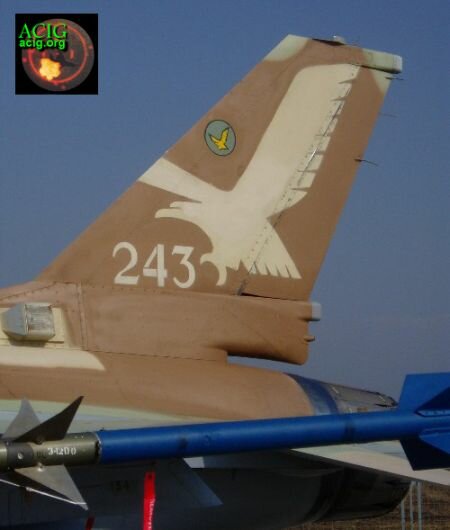|
From ACIG.org Middle East Database
The first F-16s arrived in Israel in July of 1980, within the frame of the Peace Marble I program. The first Israeli Falcons went off the assembly line in Fort Worth as early as January of that year, but they were first flown to Hill AFB. There, a number of Israeli ground and air crew underwent a conversion course for the new aircraft. The PM I deal consisted of 75 F-16A/Bs: 67 single seat A models, and 8 twin seat Bs. All 8 F-16Bs delivered under the program were built as Block 5s, while the F-16As were a combination of Block 5, 10, and 15 aircraft. The F-16A/B is known as the “Netz” (Hawk) in Israeli service. The A models received serial numbers in the 1XX and 2XX range, while the Bs were numbered in the 0XX range. Although the first batch of aircraft is known to have received “personal” names, the practice was apparently soon discontinued. The first squadron to convert to the new aircraft, in July of 1980, was 117 the “First Jet” squadron. The CO was Lt. Col Ze’ev Raz. The unit previously operated the Gloster Meteor, Dassault Mirage IIICJ, and the IAI Kfir. Next in line to receive the new aircraft, in September of the same year, was 110 “Knights of the North” squadron. The CO was Lt. Col Amir Nahumi. This squadron formerly operated the DeHavilland Mosquito, Sud Aviation Vautour, and the Douglas A-4 Skyhawk. Both units were stationed at Ramat David AB, a short distance from the borders with Syria and Lebanon. It wasn’t long before the F-16 was put to the test. Israeli Falcons began performing combat air patrols over the skies of Lebanon as the two squadrons were achieving operational capability. The first air-to-air victory came on April 28 1981. An F-16A (tail number 112) from 117 Squadron shot down a SyAAF Mi-8 in the Bekaa Valley with its cannon following a failed attempt to hit the helicopter with an AIM-9 missile.
Just over a year after being introduced into the IDF/AF roster, the Netz took on what was to become it’s most prominent mission to date (no, not the filming of “Iron Eagle”!). Eight F-16s were tasked with the destruction of the Osirak nuclear reactor, under construction in Iraq in what was code named ‘Operation Opera’. The raid was conducted on the afternoon of June 7th, 1981. Four aircraft from each of the two squadrons were dispatched to Etzion AB in the Sinai Peninsula, earlier in the day. The aircraft were each loaded with a pair of 2000lb bombs and three external fuel tanks, as well as a pair of air-to-air missiles to provide a rudimentary self defense capability. Hot refueling was performed short of the runway to compensate for fuel lost taxying. The 600nm flight to the shores of the Euphrates was conducted at an altitude of 150ft above the surface of the Saudi and Iraqi deserts. The return trip could not be flown at such a low altitude due to fuel limitations, but was timed so that the formation would fly into the sun, making visual identification by chasing interceptors more difficult.
In order to make the operation possible at all the IDF/AF had to modify procedures relating to the disposal of the external drop tanks. Since the tanks would have run dry relatively early in the flight, the Israelis could not afford to have the strike aircraft flying with the now useless, and drag-inducing tanks all the way to Osirak, where they could be dropped once the bombs on stations 3 and 7 were gone (as per the procedure accepted at the time). Flight tests had to be conducted prior to the mission to ensure that the drop could be performed safely with the bombs still in place. Nevertheless, the F-16s still could not realistically defend themselves against an air-to-air threat due to the limited amount of fuel remaining. As a result the planners decided to have the strike package escorted by six F-15A/Bs.
The strike itself went on rather smoothly, with the aircraft having achieved good hits on the target. Although the F-16s encountered resistance in the target area (mainly in the form of AAA, as well as at least one MANPAD launch), the threat of hostile interceptors on the return trip did not materialize, and all the aircraft returned uneventfully to Etzion. In the aftermath of Operation Opera, Israel faced sharp criticism for its aggressive actions. As a form of penalty, the U.S. imposed a temporary halt to the supply of American-made warplanes to the IDF/AF, after all it were U.S. made aircraft that were used to conduct the highly controversial operation against Iraq. That decision meant that the remaining portion of the Peace Marble I program deliveries (consisting of 22 F-16A Block 10/15) were suspended for a few months. Once deliveries resumed, in late 1981, the aircraft were used to form a third unit flying the F-16 in the IDF/AF. The unit was to be 253 “Negev” squadron, disbanded in early 1981 when its base in the Sinai Peninsula was deactivated, as a prelude to the area’s return to Egyptian control. The squadron formerly operated the IAI Nesher (Mirage 5), and the Dassault Mirage IIICJ/BJ. The unit was at first re-opened as part of 110 Squadron at Ramat David in October of 1981. In February of 1982 it moved to the newly inaugurated Ramon AB in the south of Israel. By that time it had 16 aircraft in its possession and was under the command of Lt. Col. Gideon Livni. The last aircraft delivered, F-16A tail number 299, joined 601 Squadron, better known as the IDF/AF’s Flight Test Centre (MANAT).
The aerial aspect of the Lebanon War was essentially composed of a battle between the IDF/AF and the SyAAF, as well as both countries’ respective air defense forces. As war broke out on June 6, both air forces began to support ground operations, with limited amount of contact with the other side’s air and air-defense assets. The situation changed on June 9. With the advance of IDF forces north, the IDF/AF could no longer ignore the massive array of SAM and AAA systems the Syrians deployed in Lebanon’s Bekaa Valley a year earlier. The IDF/AF set out to destroy the 19 SAM batteries and their support network in a major operation consisting of several waves, each made up of dozens of attack aircraft employing a variety of guided and un-guided air-to-ground ammunition, backed by some ground launched Shrike anti-radar missiles, as well as a massive screen of ECM and decoys. More than 60 Syrian interceptors (all different versions of MiG-21 and -23s) – which was slightly more than the Israelis expected – were scrambled to defend the air defense network, clashing with dozens of Israeli fighters to produce what could very well be the biggest jet dogfight in history. The SyAAF suffered considerable losses (estimated at 25 aircraft) at the hands of IDF/AF F-15s and F-16s, tasked exclusively with air-to-air missions. More clashes followed on the 10th and 11th when the SyAAF not only attempted to challenge the Israeli control of the skies over Lebanon, but also to strike advancing Israeli units on the ground. The official count at the end of the war had IDF/AF F-16s credited with a total of 44 air-to-air victories. The vast majority of these were achieved with air-to-air missiles, namely the AIM-9L Sidewinder and the Python 3. 5 of the 44 kills were attributed to 253 Squadron. The rest were roughly evenly distributed between 110 and 117 squadrons; both stationed a mere 80nm from the battlefield. The last kills of the F-16 in Israeli service to date took place less than two weeks after the end of the war. 107 is the highest scoring individual F-16 in the IDF/AF with 6.5 kills. It also took part in operation Opera, and wears a green triangle next to its other kill marks to show for it.
As with other operators of early F-16s, the IDF/AF suffered a high number of accidents too. Two F-16As were lost over the course of 1981 (222, 257). Two aircraft (266, 276) from 253 squadron were lost early in 1982 when they collided with each other during a training mission. 225 and 227 were written off in separate accident in 1983. By 1988, at least seven additional F-16A/Bs were lost (including 121, 240, 003, 008, 015, and 277). Another mid-air collision in 1995 saw the loss of 290 and 269, both with 253 Squadron at the time. 2000 was another unlucky year, with 237 (140 Squadron) and 248 written off due to accidents. A pair of Peace Marble IV F-16A/Bs were also written off in the late 90’s, more on that later. Following the successful introduction of the F-16A/B into Israeli service, the IDF/AF sought to acquire more of the aircraft. This materialized in the form of the Peace Marble II program, which saw the delivery of 75 F-16C/Ds Block 30. The first squadrons to receive the new fighters were again 117 and 110. This meant that the A/Bs at their disposal were to be transferred to other units. Thus, during the summer and fall of 1987, these aircraft were transferred to Ramon AB, and put into service with 253 and 140 squadrons. 140 “Golden Eagle” squadron previously operated the North America AT-6 Harvard and the Douglass A-4 Skyhawk. It was re-formed using the aircraft of 117 and some of 110 squadron. 253 was augmented with the remaining aircraft of 110 squadron. This brought the strength of each of these two units up to just over 30 F-16A/Bs. It appears that some airframes have been transferred between the two squadrons during the 90’s.
As the more advanced F-16C/D Block 30 and 40s entered service as part of the Peace Marble II and III programs, the IDF/AF looked to upgrade its fleet of F-16A/Bs to offer increased commonality and better performance. An improvement program was initiated in the early 90’s, which saw the avionic of the entire “Netz” fleet upgraded to a level that is said to be nearly identical to that of the “Barak” (as the F-16C/D is called by the IDF/AF). It is unknown whether the modifications were sweeping enough to cover the radar and cockpit layout, but both are unlikely to have taken place. The aircrafts’ airframes were also strengthened as part of the program. Seeing as the F-16A/B has been a primarily air-to-air fighter (although its pilots are still proficient at the employment of unguided bombs) for the IDF/AF for over a decade, it is logical to assume that the Netz has the ability to employ Israel’s all-aspect, high off-boresight angle Python 4 AAM. The Python 4 is known to be carried on IDF/AF F-15A/B/C/D/Is, as well as F-16Cs. The ability to employ Israel’s Derby, an active radar homing medium range AAM, is also possible. As a reward for Israel’s restraint during the Gulf War, the U.S. administration supplied the IDF with a number of systems from U.S. military surplus. The IDF/AF was granted with used AH-64s, UH-60As, F-15A/Bs, and a number of F-16A/Bs. The F-16A/Bs were delivered starting with August 1994, under the Peace Marble IV program. 36 Block 1/5/10 F-16As and 14 Block 1/5/10 F-16Bs were supplied, approximately half came from USAF ANG and AFR units who were converting to more advanced versions. The other half were taken out of AMARC storage. A few of the aircraft were Desert Storm veterans. As these Falcons differed in their various systems from the rest of the F-16A/B fleet they became known as the “Netz II”. The aircraft joined 144 (“The Guardians of the Arava” a.k.a. “Phoenix”) Squadron at Hatzor AB, which previously operated the IAI Nesher, and was the last active IDF/AF Kfir unit. This made 144 the biggest fighter squadron (in terms of number of aircraft operated) for several years. The single seat A models were numbered in the 7XX range, while the twin seat Bs were allocated numbers in the 9XX range (974 and up).
As the aircraft awaited their turn to undergo an improvement program that would bring them up to par with the rest of the IDF/AF’s F-16A/Bs, they retained their grey USAF camouflage scheme. A number of PM IV F-16Bs soon found their way to other IDF/AF units. 993 joined the Flight Test Centre. 974, 979, and 983 were transferred to 253 Squadron. 984, 990, and 991 went to 140 Squadron. Furthermore, 986 was later given to Israel Aircraft Industries where is serves as a demonstrator for the company’s ACE upgrade program (allocated a civil registration, 4X-ACE). The upgrade program which appears to have been finished by the turn of the century marked the disappearance of the grey camouflage scheme from the IDF/AF ranks (with all PM IV aircraft painted in the traditional desert scheme), and also saw the dispersal of a few additional aircraft away from 144 squadron. At least 6 PM IV F-16As (728, 729, 733, 737, 766, 776) were transferred to 253 Squadron. As a result, 253 had 36 active aircraft in early 2003, and perhaps a few more undergoing maintenance. At least 2 aircraft are known to have been lost since joining the IDF/AF in 1994. 750 was lost in a ground fire at Hatzor sometime in the mid 90’s, with its front section now serving as a ground simulator. 991 was lost to a bird strike in 1997 while on a training mission. Another F-16B has been reported as lost in 2000, but it is unknown whether it was a PM I or PM IV example. As a result of the increased number of twin seaters in service (5-6 in each of the 3 squadrons), the IDF/AF moved to add dedicated navigators (similar to WSOs and RIOs in other countries) to man the back seat on F-16Bs in the mid to late 90’s. The pending arrival of another batch of new built F-16s, in the form of 102 F-16I Block 52s under the Peace Marble V program, prompted a reorganization in the structure of F-16A/B units within the IDF/AF. 253 Squadron was the first to convert to the F-16I, with first deliveries having taken place in January of 2004. In preparation for the arrival of the new aircraft, 253’s “old” aircraft and personnel moved from Ramon to Nevatim AB in March 2003. There they re-formed 116, the “Flying Wing” squadron, a former North American P-51D and Douglass A-4 Skyhawk unit. 140 Squadron followed a few months later. Nevatim is slated to become the IDF/AF’s largest base, with the planned relocation of all heavy transport squadrons (2 C-130, 1 B-707, and 1 Gulfstream/IAI Arava squadrons) to the airbase in the near future. 144 squadron remains at Hatzor for the time being. As censorship and secrecy measures became less restrictive in the early 1990’s, more IDF/AF units began applying creative insignia on their aircraft. 144 squadron began the trend (in the F-16A/B community that is) when it applied the image of a red phoenix covering most of the vertical stabilizer of their aircraft. 140 Squadron followed suit by applying the graphic of a large gold colored eagle spreading its wings across the vertical stab of their Falcons. Lastly, since taking over the F-16A/Bs of 253 squadron, 116 has already painted their aircraft with an enlarged tan-colored version of their symbol, a silhouette of a prey bird’s wing and head, strung across the tails of their F-16s.
© Copyright 2002-3 by ACIG.org |

